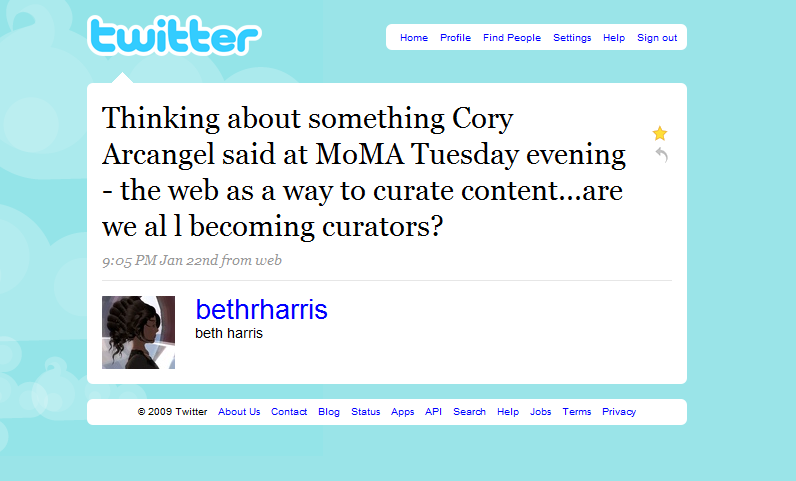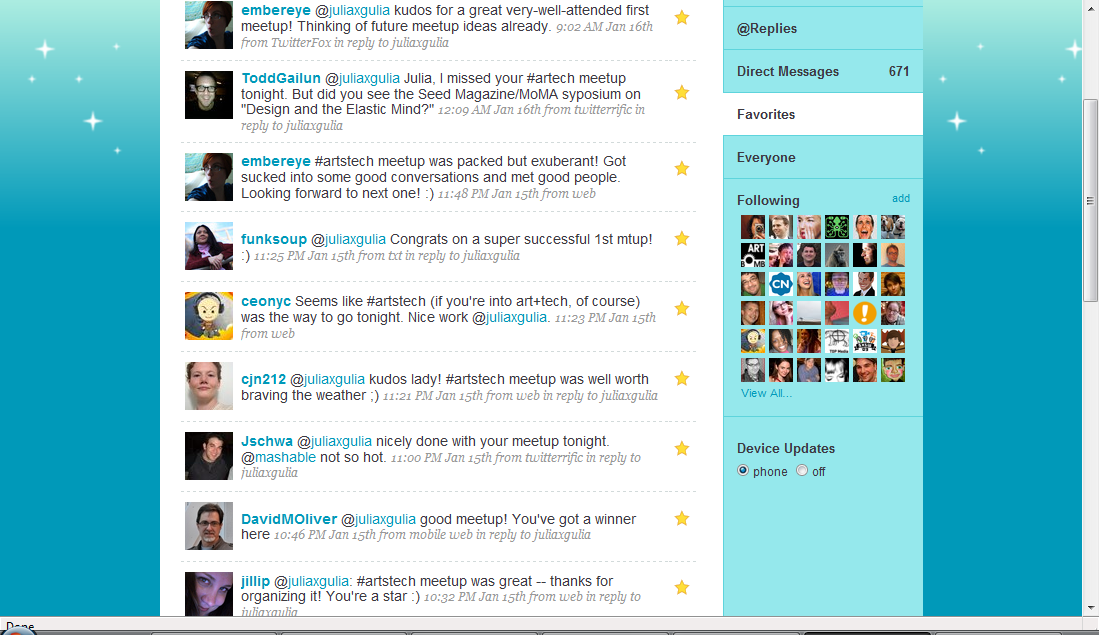Artist's Social Media Toolkit
 Sunday, January 25, 2009 at 05:13PM
Sunday, January 25, 2009 at 05:13PM 
At my meetup last week, I met a lot of artists who were interested in learning more about how to promote themselves on the web and get their work in front of people. It got me thinking about availble resources online that individual artists could use to self-publish their work, exchange ideas with fellow artists and interact with existing and potential customers/fans. Then, this past Thursday, @bethrharris (Director of Digital Learning at the MoMA and one of the masterminds behind http://www.smarthistory.org/, the most beautiful art history "web-book" I've seen to date. Their use of multimedia is excellent and the content is smart, rich and fascinating.) posted a comment on Twitter about whether the internet turns the individual into a curator and I haven't been able to get the thought out of my head since.
On the web, the artist has an opportunity to circumspect the gatekeepers at traditional galleries and museums (I'm writing in the context of visual art, but these ideas can be applied to just about anything, I think) and curate his own show, where the work is showcased in dozens of different "exhibition halls" all around the web--for instance Flickr, YouTube, perhaps an online community, or a widget. Ideally, the artist would also increase engagement with his audience by de-mystifying the artistic process and helping provide context to the work and what inspired it in the form of a blog or a podcast. Each new work could be documented in the conception and execution phases, the process and thoughts behind it could be explained, the audiences questions could be answered.
In any case, if I were an artist, here are some things I'd be doing to "curate" my web presence:
1. Keep a blog. It doesn't have to be anything fancy--even just something you post on as little as once a week should suffice, provided that one weekly post be one you've put some time and thought into. Write about what you're working on, what you've been doing lately, what has inspired or intrigued you as of late (if possible, you could throw up a link to it, too), maybe some pictures if you're a visual artist, or an audio sample if you're a musician. Keep an almost journal-like account of what you did that day, what you're thinking about.
Beyond that, your blog should become your home base. Set up a gallery of your work to showcase new and existing projects. If your work is for sale, indicate so and set up a PayPal or other system through which your audience can buy your work at the click of a button. The Art K. MacGuffin blog, for instance, is essentially just a virtual marketplace of art for sale with a few podcasts thrown in to liven up the site.
2. Consider starting a video blog. For those who feel comfortable in front of the camera, a vlog might be an excellent supplement (or even substitute) to a traditional blog. Video is undeniably an entertaining and engaging medium, and equipped with a webcam and some basic editing software, you could effectively do what Valerie at Val's Art Diary does. She started a very popular YouTube channel where she posts weekly videos of her painting, interspersed with some random thoughts and musings. Her social media presence, driven largely by the success of her YouTube vlog, is what keeps her in business and helps her sell her work and get commisions. It's also landed her on Wall Street Journal and FoxNews. You can read some more of her tips for artists here.
3. Make connections on Twitter. I'm a huge Twitter advocate, mostly because I've had so much success with it myself. It's a great way to make connections with people from all over the world--and when I say connections, I don't just mean in a "networking" sense. I really mean when you connect with someone over a shared interest or a point of common ground. I would start out searching for people on Twitter who have similar interests as me by using search.twitter.com to find people who are tweeting about the topics I'm interested in. I'd start following them. If they ever tweeted something that stuck a chord with me, for whatever reason, I'd probably say so, and in that way, start a dialogue with them. A few such interactions, and before you know it, you'll have a new friend. Then, see who they interact with and look for the interesting people in their social circle. Basically it builds from there. The stronger your relationships become with these people, the more likely they'll be to check out your latest blog post or comment on your newest work. Twitter, at least for me, is more akin to a community of folks, and I often turn to them with questions or calls for help. The best part is--they listen and answer.
4. Join an online community. Speaking of communities, you should join one. There are tons of online communities [read: social networks, messageboards, forums] for artists, musicians, actors, dancers, etc. Find the ones that more apply to or interest you and join one. If I were a visual artist, I might join DeviantART or Artlog, not just because they're places where I can showcase my work, but also because I can participate in a conversation with my peers, share information and ideas, strike up friendships and collaborations, and accrue a support system for myself via this virtual community.
5. Search for opportunities to display your work. One of the best things about the web is that it's a place of constant change and innovation. New websites, businesses, applications and widgets are cropping up every day, and many of them may be excellent opportunities for you to get your work in front of an audience. The wider you cast your net, the greater your chances of making a sale or scoring a commission--you never know who your work will wind up in front of, or how they may react to it. One thing to remember though, is to make sure all roads lead back to you (or, rather, to your home base--your blog) and at every opportunity available, your contact info or, when appropriate, a "Buy Now" button, are prominently on display.
Some examples of the kinds of opportunities I mean:
Art for iPhone, Artzilla, Add-art.org
I'm sure there are lots other out there. I found out about these via Twitter, blogs, and online communities, which is why it's good to participate in, or at least listen to, the discussions your peers are having in these spaces.
These are what I consider the "essentials." What else do you think should be on this list? I welcome your thoughts!





